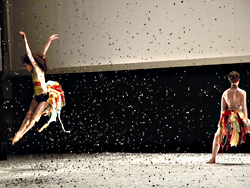Most founders of American modern dance hated ballet the same way the Puritans hated the Papists. Ballet was elitist, unnatural, artificial, and foreign, a desiccated relic of the Old World, the antithesis of the new, American art form they were striving to create. But since those earlier doctrinaire times, modern dancers have snuck back to visit the genre their forebears rejected. Ballet has crept into contemporary dance practices and been put to many different uses.
Some dancers treat it like cod liver oil, a practice that’s good for you but not very pleasant. They’ll take ballet class to build strength or flexibility, like a kind of style-free training regime, but ignore the aesthetic that might come along with it. Others, though, will take on the whole package—the physical attributes and the oddly elegant world they come from. Zoe Scofield is one of these others. Collaborating with visual artist Juniper Shuey, Scofield seems to be looking at ballet through an eccentric lens, showing us the animal nature behind the refined practice.
In the devil you know is better than the devil you don’t at On the Boards last week, Scofield took standard structures and vocabulary and presented them as a kind of animist version of traditional forms. With unconventional variations on the standard port de bras, with toes digging into the floor and limbs torqued so far the rest of the body twists in response, she took academic dance out of its standard framework and transported it into a natural world. In the 2005 i am nothing without you, Scofield’s dancers looked like a cast from the romantic ballet Giselle stranded in an actual forest graveyard; the performers in devil are much less fragile than that earlier group, but their surroundings, and their relationship to them, are similar.
Throughout her choreography, both for her own ensemble and for other groups, Scofield seems to be tugging at her own dance background, particularly her years in ballet. By peeling away some of the conventions of that tradition, by shifting its context, she shows a world that is as strange as it is beautiful.
Devil opens with a “snowstorm,” spots of light falling down a scrim hanging across the front of the stage, with ghostly figures seeming to flit along the screen. As the lights go up and the scrim falls down, we see real bodies crouch and skim across the stage, but the chilly feeling remains. These are wild animals as much as they are trained artists, moving with great clarity and elegance in a different world. When a large ensemble enters wearing long white gloves, they look like gazelles or Greek statues, as well as like opera ladies.
There isn’t an overt narrative in devil, or even the implied narrative of theme and variation—Scofield doesn’t seem to be playing the postmodern puzzle games that organize many other dance works. Instead, it feels much more like a nature documentary, as we look at herding behaviors and mating rituals. The pulse in the upper body that bobs along in rhythm with a gallop across the stage could come from a herd of horses or from a crowd of kids on the playground. The cross-lateral twist of the body in repose that is the bedrock for most ballet technique carries echoes of giraffes browsing in the trees or elephants striding deliberately across a plain.
Scofield’s movement choices are eccentric, but these organic connections make them feel inevitable, so that when a couple leaves the stage after a duet, we don’t think twice about seeing her support his neck with the top of her foot as he rolls along the floor. Rather than feeling like a manipulative trick, it’s a moment of connection and tenderness.
With devil Scofield and Shuey have come to a new balance in their collaboration. Shuey’s stage environments can be overwhelming sometimes, making the dance seem unfocused, but his set for this work—a black-and-white curtain around three sides of the stage used for more projections, as well as the opening scrim—creates a strong box for the movement inside, repeated in some of the lighting effects. By the end of the dance, with confetti snow falling on the performers, the ghosts that we saw at the beginning have returned as the dancers themselves, picking and twisting through the space. And Zoe Scofield has made peace with all her movement ancestors, whatever their point, or pointe, of view.








